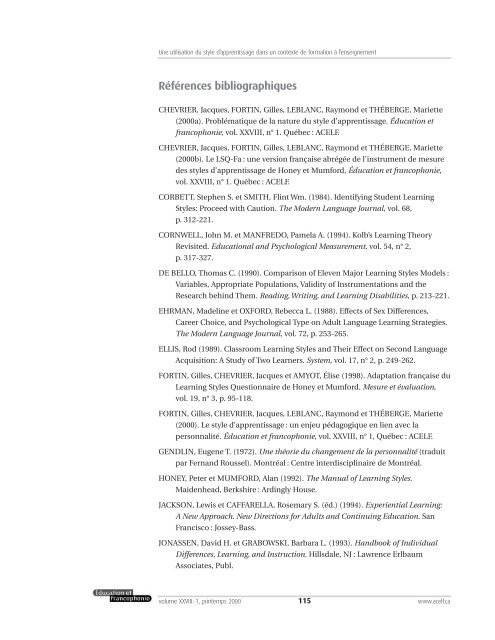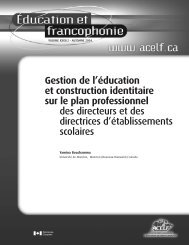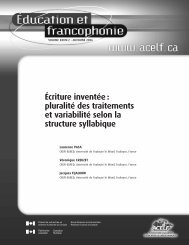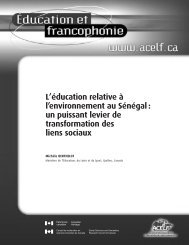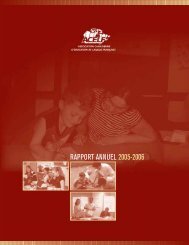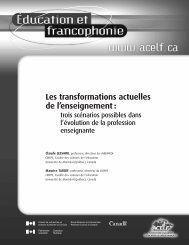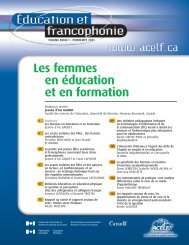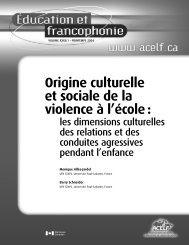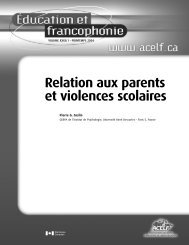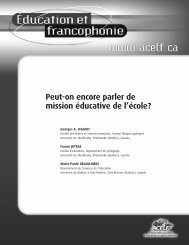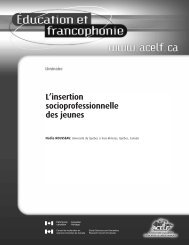Create successful ePaper yourself
Turn your PDF publications into a flip-book with our unique Google optimized e-Paper software.
Une utilisation du <strong>style</strong> d’apprentissage dans un contexte de formation à l’enseignementRéférences bibliographiquesCHEVRIER, Jacques, FORTIN, Gilles, LEBLANC, Raymond et THÉBERGE, Mariette(2000a). Problématique de la nature du <strong>style</strong> d’apprentissage. Éducation etfrancophonie, vol. XXVIII, n° 1. Québec : ACELF.CHEVRIER, Jacques, FORTIN, Gilles, LEBLANC, Raymond et THÉBERGE, Mariette(2000b). <strong>Le</strong> LSQ-Fa : une version française abrégée de l’instrument de mesuredes <strong>style</strong>s d’apprentissage de Honey et Mumford, Éducation et francophonie,vol. XXVIII, n° 1. Québec : ACELF.CORBETT, Stephen S. et SMITH, Flint Wm. (1984). Identifying Student <strong>Le</strong>arningStyles: Proceed with Caution. The Modern Language Journal, vol. 68,p. 312-221.CORNWELL, John M. et MANFREDO, Pamela A. (1994). Kolb’s <strong>Le</strong>arning TheoryRevisited. Educational and Psychological Measurement, vol. 54, n° 2,p. 317-327.DE BELLO, Thomas C. (1990). Comparison of Eleven Major <strong>Le</strong>arning Styles Models :Variables, Appropriate Populations, Validity of Instrumentations and theResearch behind Them. Reading, Writing, and <strong>Le</strong>arning Disabilities, p. 213-221.EHRMAN, Madeline et OXFORD, Rebecca L. (1988). Effects of Sex Differences,Career Choice, and Psychological Type on Adult Language <strong>Le</strong>arning Strategies.The Modern Language Journal, vol. 72, p. 253-265.ELLIS, Rod (1989). Classroom <strong>Le</strong>arning Styles and Their Effect on Second LanguageAcquisition: A Study of Two <strong>Le</strong>arners. System, vol. 17, n° 2, p. 249-262.FORTIN, Gilles, CHEVRIER, Jacques et AMYOT, Élise (1998). Adaptation française du<strong>Le</strong>arning Styles Questionnaire de Honey et Mumford. Mesure et évaluation,vol. 19, n° 3, p. 95-118.FORTIN, Gilles, CHEVRIER, Jacques, LEBLANC, Raymond et THÉBERGE, Mariette(2000). <strong>Le</strong> <strong>style</strong> d’apprentissage : un enjeu pédagogique en lien avec lapersonnalité. Éducation et francophonie, vol. XXVIII, n° 1, Québec : ACELF.GENDLIN, Eugene T. (1972). Une théorie du changement de la personnalité (traduitpar Fernand Roussel). Montréal : Centre interdisciplinaire de Montréal.HONEY, Peter et MUMFORD, Alan (1992). The Manual of <strong>Le</strong>arning Styles.Maidenhead, Berkshire : Ardingly House.JACKSON, <strong>Le</strong>wis et CAFFARELLA, Rosemary S. (éd.) (1994). Experiential <strong>Le</strong>arning:A New Approach. New Directions for Adults and Continuing Education. SanFrancisco : Jossey-Bass.JONASSEN, David H. et GRABOWSKI, Barbara L. (1993). Handbook of IndividualDifferences, <strong>Le</strong>arning, and Instruction. Hillsdale, NJ : Lawrence ErlbaumAssociates, Publ.volume XXVIII : 1, printemps 2000115www.<strong>acelf</strong>.ca


